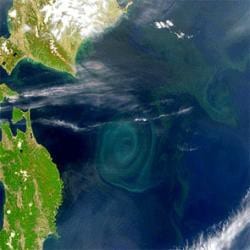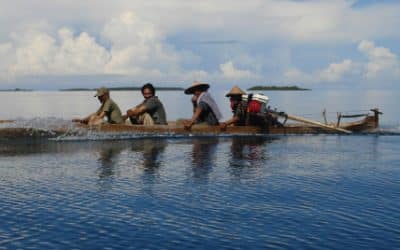by Catherine Brahic (New Scientist)

Ocean plankton blooms appear as green patches in the blue of the oceans. Some say they could be used to soak up human CO2 emissions (Images: SeaWiFS Project/NASA and GeoEYE)
Update 25 June 2007: The scientific working group of the London Convention expressing its concern regarding “the potential for large-scale ocean iron fertilisation to have negative impacts on the marine environment and human health” on 22 June. The group has requested that the full London Convention, which meets on 5-9 November 2007 “considers the issue of large-scale ocean iron fertilisation operations with a view to ensuring adequate regulation of such operations”. Read the full statement of the scientific working group here.
Original article, 22 June 2007: A private company’s plans to dump 100 tonnes of iron particles into the Pacific Ocean off the Galapagos, to trigger a plankton bloom, are being discussed by the International Maritime Organization today.
The chief executive of carbon-offsetting firm Planktos says the scrutiny is unwarranted as the amounts of iron his company will dump are minuscule.
Planktos is a private company which sells UN-approved carbon credits and uses the money for forestry projects. It plans to sell carbon “off-set” credits to fund future ocean iron-dump projects.
The US company is also one of a few budding organisations seeking to operate large-scale experiments to dump fine iron particles into the ocean in order to boost the growth of tiny plant plankton, called phytoplankton.
Natural clouds of iron dust deposited on the sea by the winds can trigger large plankton blooms that can be seen from space as greenish patches in the midst of blue ocean waters.
In the past 20 years, 10 ocean expeditions around the world have attempted to trigger phytoplankton blooms by purposefully seeding the waves with fine iron dust.
Controversial experiment
Some believe these experiments could be a solution to rising levels of carbon dioxide in the atmosphere: as the phytoplankton grow into blooms, they absorb the gas from the atmosphere, much like trees do. A portion of this sinks to the sea floor when the plankton die, effectively transferring CO2 from the atmosphere to the bottom of the ocean.
Some experts believe that experimenting with ocean iron-dumps should be accelerated and that academic research has been too limited. However, most are concerned that iron-dumping may have disastrous effects on the local ecology and biodiversity. Phytoplankton are right at the bottom of the marine food-chain and tampering with the amount of phytoplankton in the oceans may effect the entire marine ecosystem.
Victor Smetacek of the Alfred Wegner Institute for Polar and Marine Research agrees that too little is known about phytoplankton. That is precisely why he would like to see more iron fertilisation experiments carried out under international agreement and regulated by a United Nations body. “I am probably the only senior scientist who is advocating this, however,” he told New Scientist. “The way I see it is the experiments should be run by scientists [not by private companies], but the scientific community as a whole is against this.”
Smetacek has just received funding from the Indian government to carry out an iron fertilisation experiment in the Scotia Sea, off the coast of Antarctica, in 2008. In the long run, he says iron fertilisation activities should be run by a dedicated United Nations body.
Outside the law?
Each of the 10 expeditions carried out so far have dumped up to 10 tonnes of iron particles. Planktos intends to take the iron fertilisation experiments further than publicly-funded research has so far.
It is planning six expeditions, each of which will dump up to 100 tonnes of iron. It says it will study the plankton bloom more extensively and for longer than has been done in the past.
A US civil society organisation called the International Center for Technology Assessment (CTA) believes that Planktos’s planned activities are in breach of law.
“There is a law against dumping material into the ocean without permits. Yet, this is exactly what Planktos plans on doing,” says staff attorney George Kimbrell of the CTA. “We are asking the US Environment Protection Agency [EPA] to launch an immediate and full investigation into Planktos’s ocean-dumping activities.”
When New Scientist contacted the EPA, it was told that Planktos has indicated to the agency that it will dump the iron particles from a ship registered outside the US, thereby avoiding any conflict with the US Ocean Dumping Act. “This is no longer within our jurisdiction,” an EP official said.
Natural substance
Planktos, whose US-registered research ship Weatherbird II is currently having equipment fitted for the first iron fertilisation expedition – scheduled to take place in international waters off the coast of the Galapagos – says that it has not yet decided whether or not it will operate from this vessel.
Planktos chief executive Russ George told New Scientist that it is awaiting formal notification that its activities are not legal under US law.
If it receives such notification, says George, it will consider dumping the iron from a foreign ship and carrying out the subsequent monitoring research from Weatherbird II.
George says the quantities of iron his company is proposing to dump are well below quantities that require EPA approval under the US Ocean Dumping Act.
“The act states that if you are putting a natural substance into the ocean you don’t have to apply for a permit,” says George. He says the iron particles he uses are very finely ground particles of haematite, a rock that is naturally rich in the mineral.
Low concentrations
“The other clause is that if you don’t raise the concentration of the substance in the ocean to 0.01% of acute toxicity levels you don’t need to apply,” says George.
“We are seeking to raise concentration of iron to something in the neighbourhood of 50 parts per trillion. When I looked up the acute toxicity of iron I couldn’t find it, but I could find that the concentration of iron in breast milk is tens of parts per million. Over the counter iron supplements contain 100 ppm.
“We are a million times below the level required to maintain life, not 0.01% below the level of acute toxicity,” concludes George. “When I pointed that out to the EPA they said: ‘Well we don’t have to go by that’.”
George says he is now awaiting formal notification from the EPA in order to decide what ship to dump his iron from. The EPA says the matter is no longer under its jurisdiction because Planktos has told them it will not dump from a US ship.
Careful evaluation
Meanwhile, the US government has apparently not turned its back on the matter entirely. The scientific working group of the International Maritime Organization’s London Convention, which regulates dumping at sea, is meeting from 18 June to 22 June in Spain.
A document submitted by the US government has required that Planktos’s activities be considered by the IMO.
The document states: “Because this iron release project will not be done by vessels flagged in the US, or by vessels leaving from the US, the US government does not have jurisdiction to regulate this project under its law implementing the London Convention.
“The US believes that the iron addition projects proposed by Planktos, Inc. should be evaluated carefully by any state that has appropriate jurisdiction over this activity.”
Originally posted by New Scientist.



